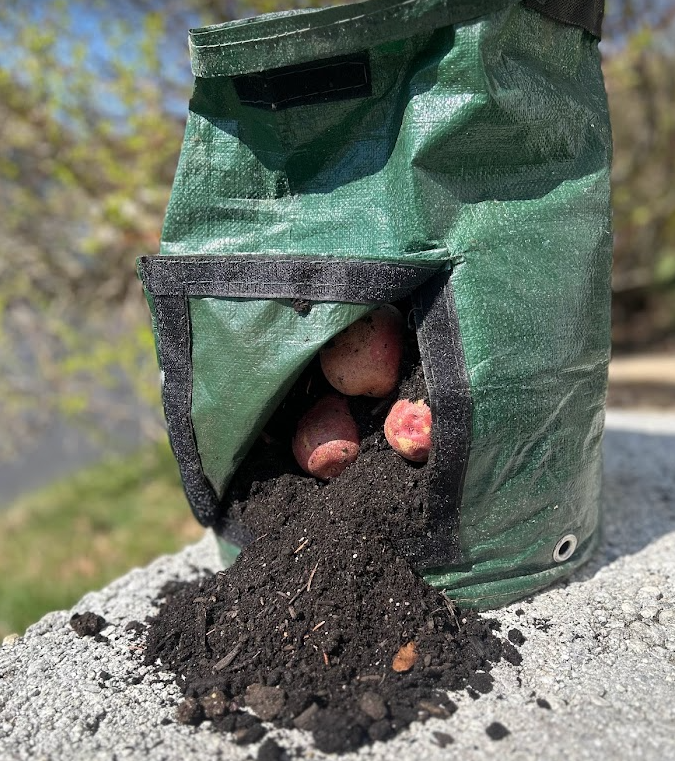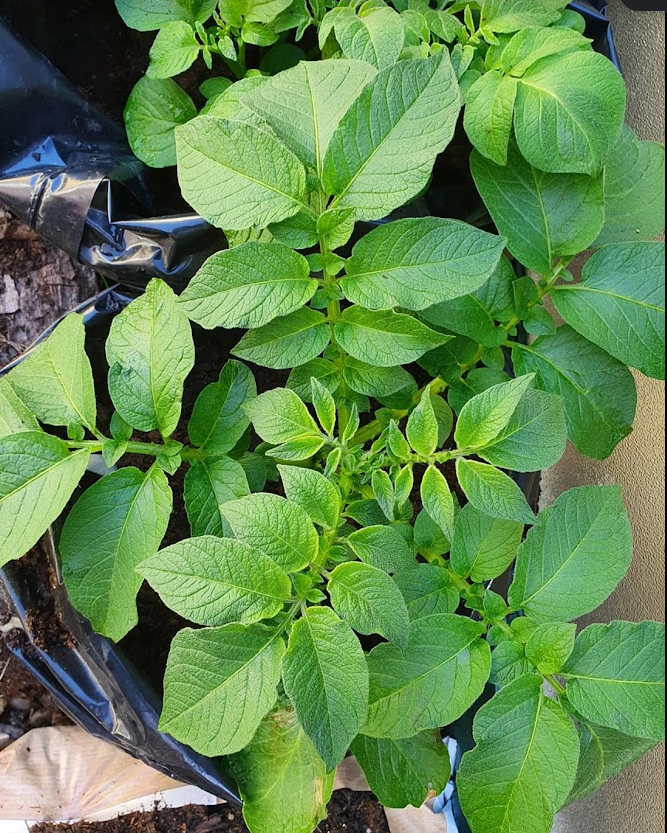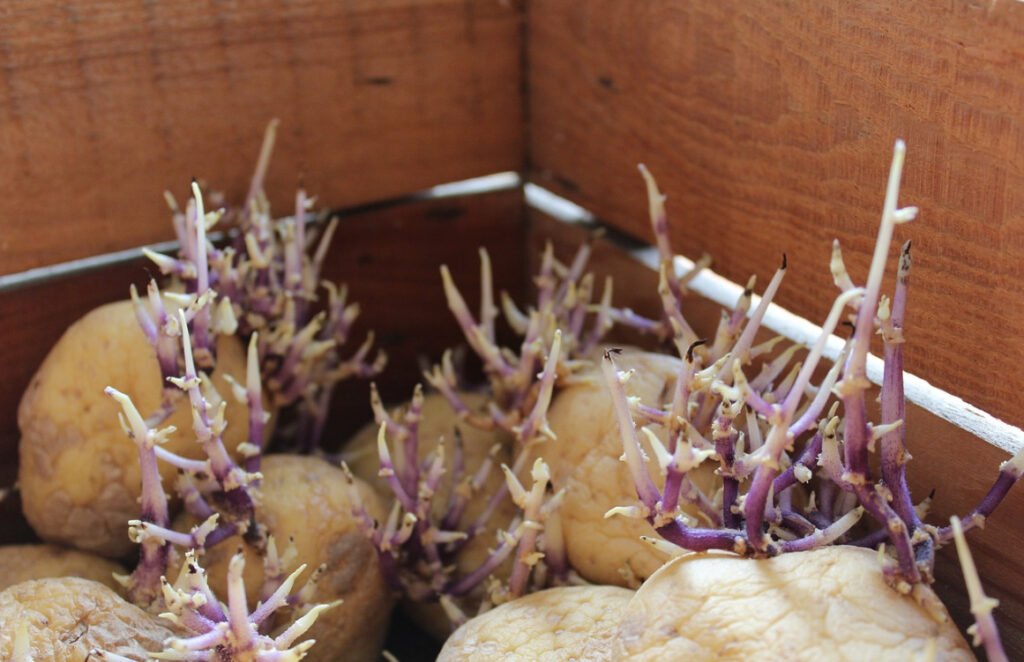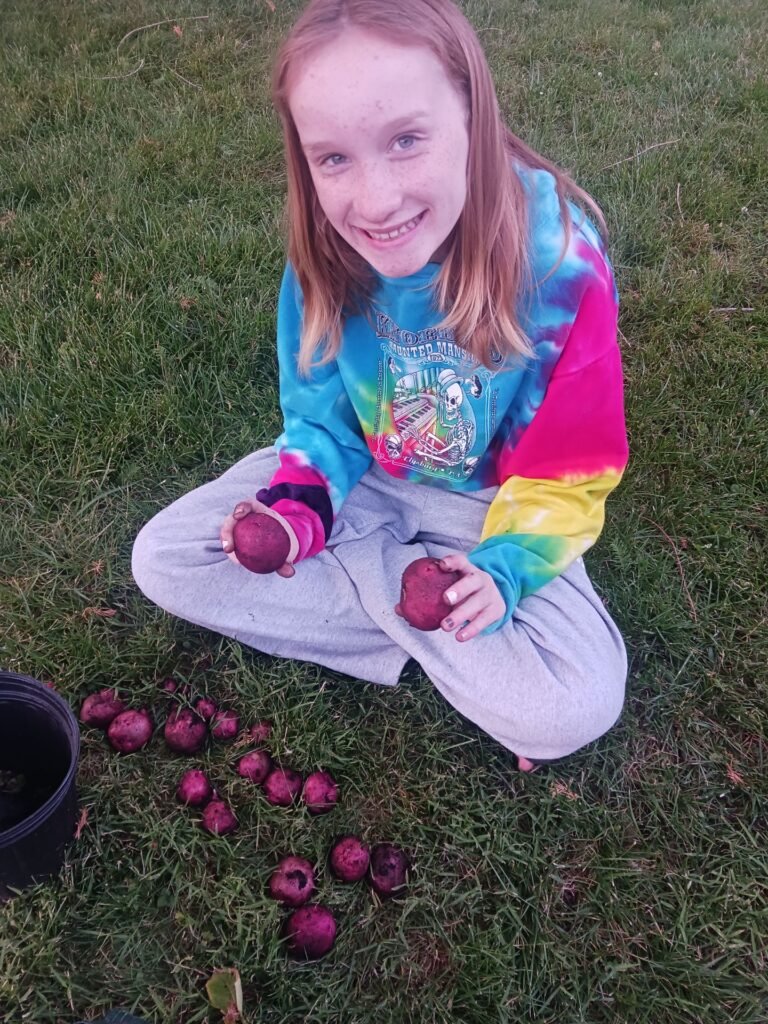Imagine stepping out onto your patio, balcony, or home and plucking a handful of freshly harvested potatoes, nurtured by your own hands. Picture the satisfaction of knowing exactly where your food comes from, even in the midst of this crazy world. With the rising costs of today’s living, it’s nice to know that we can grow our own healthy foods in our own space. Growing potatoes in containers is not only a practical solution for those with limited gardening space, but it’s also a rewarding experience that connects you with nature and your food source. By utilizing containers, you have the ability to create your own mini potato garden, right at your fingertips.
In this short article, we will guide you through the process of how we grow potatoes in containers. You’ll learn how to select the right containers, provide the ideal growing conditions, and navigate the growth cycle of your potato plants. Whether you’re an urban dweller with a small balcony or someone looking to maximize their garden space like we did , container potato gardening is a versatile and fruitful endeavor.
Introduction to growing POTATOES in containers
Container potato farming is becoming increasingly popular, especially in urban areas where space for gardening is limited. This innovative method allows individuals to enjoy the satisfaction of growing their own potatoes, even without a traditional garden. Urban potato cultivation not only provides a source of fresh, homegrown produce but also offers the opportunity for city dwellers to reconnect with nature and experience the joy of growing their own food. It also helps those who have larger gardens create additional space for more plants. We have a small garden at home in which we created a shelf system around the perimeter to allow our grow bags to set on. This allows more plants in less space.
With container potato farming, you can cultivate potatoes in even the smallest of spaces, such as patios, balconies, or rooftops. This efficient and space-saving technique makes it possible to grow potatoes in limited areas, transforming urban gardens into thriving potato patches.
Whether you’re an experienced gardener or a beginner, container potato farming is the perfect solution for those who are passionate about growing their own food but lack the ample space traditionally required for potato cultivation. In the following sections, we will go a little deeper into the allure of container planting and explore the benefits it offers for everyone.
Easy Harvest: The Convenience of Container Potatoes
Another appealing aspect is the convenience of container potatoes. Unlike traditional potato farming, where harvesting can be labor-intensive and time-consuming, container potatoes offer a much simpler and hassle-free process. With potato container gardening, you have easy access to the potatoes as they grow, making it convenient to monitor their progress, water them, and eventually harvest them when they are ready. Plus, it’s super easy to get them out when it’s time to harvest!
Choosing Containers for Your Potatoes
Disclosure: These links contain affiliate links, which means we receive a small commission when you click and order
When it comes to container planting, selecting the right containers is crucial for the success of your crop. There are several options available, each with its own unique benefits. One popular choice is to use grow bags specifically designed for growing potatoes. These bags are made of breathable fabric that provides excellent drainage and aeration, creating an ideal environment for healthy root growth. They also promotes air circulation around the roots, preventing them from becoming waterlogged and root bound. Additionally, the fabric bag serves as a barrier, preventing the spread of weeds and pests.

When choosing grow bags for your potatoes, consider the size and material. Opt for bags that are at least 10 gallons in capacity to provide enough space for the tubers to develop. Fabric bags made from polyester or polypropylene are durable and can be reused for multiple seasons.


Alternative Containers: Buckets, Bins, and More
If grow bags are not suitable for your potato farming needs, there are alternative container options available. Buckets, bins, and even large plastic pots can be used to grow potatoes. These containers should have drainage holes to prevent waterlogging. Ensure they have sufficient depth to accommodate the growth of the tubers.
When repurposing containers for potatoes, make sure they are clean and free from any residues or chemicals that could harm the plants. Avoid using containers made from materials that may leach harmful substances into the soil, such as treated wood or certain plastics.
Remember, regardless of the container you choose, proper drainage and aeration are essential for the health and productivity of your potato plants. Regularly monitor the moisture levels and adjust watering accordingly to create an optimal growing environment.
potato Chitting and Planting
Before planting your potatoes in containers, it is important to prepare them properly. What the heck is Chitting? Chitting is a process in potato cultivation where seed potatoes are encouraged to sprout before planting. It involves placing the seed potatoes in a cool, well-lit location for a few weeks prior to planting. This process helps jump-start the growth of the potato plants once they are planted in the soil, leading to earlier and more uniform emergence of the plants. Chitting also allows growers to identify any damaged or diseased potatoes before planting, ensuring healthier crops.
Try to stay away from grocery store potatoes because most of the time they are sprayed to help prevent sprouting. Look for varieties suitable for container gardening, such as Yukon Gold or Red Pontiac. These are our go to types of potatoes and the by far the most popular. There are other varieties that are suitable for container growing such as Red Norland, Russian Banana Fingerlings, All Blue, Kennebec, French Fingerlings, Carola, Purple Majesty, and Katahdin.
Next, place the seed potatoes in a cool, well-lit area for a few weeks.
You can chit the potatoes by placing them in an egg carton or on a tray with the eyes facing up. Make sure the area is well-ventilated to prevent moisture buildup and rot.
During the chitting period, the potatoes will develop small sprouts called “chits.” These chits will grow into the potato plant’s stems when planted.
Once the potatoes have sprouted, they are ready for planting. Prepare your containers by filling them with a well-draining potting mix, leaving about 4-6 inches of space at the top.
Place the chitted potatoes in the containers, with the sprouts facing up. For larger containers, you can plant multiple potatoes, spacing them about 8 inches apart.
Gently cover the potatoes with soil, leaving the sprouts exposed. Water the containers thoroughly and place them in a sunny location.
As the potatoes grow, gradually add more soil to the containers to cover the sprouts. This is known as “hilling.” Hilling helps promote additional tuber development and prevents tubers from turning green.
Continue to water the containers regularly, keeping the soil evenly moist but not waterlogged.
Soil Requirements for Container-Grown Potatoes
When it comes to growing potatoes in containers, providing the right soil conditions is essential for ensuring healthy plant growth and a bountiful harvest. In this section, we will discuss the soil requirements for potatoes, including the ideal pH level, texture, and nutrient content. We will also highlight the importance of good drainage and recommend suitable soil mixes for successfully growing potatoes in containers.
Ideal pH Level
Potatoes thrive in slightly acidic soil with a pH range of 5.0 to 7.0. It is crucial to test the pH level of your soil to ensure it falls within this range. This can be done using a pH testing kit, which is widely available at garden centers or online.
Texture and Drainage
Potatoes prefer loose, well-draining soil that allows for optimal root growth. A loose texture promotes good aeration and prevents waterlogging, which can lead to root rot. To improve drainage, you can amend your soil mix with organic matter such as compost or coconut coir. Check out our other blog on how to compost for beginners.
Nutrient Content
Potatoes have specific nutrient requirements to support their growth and development. It is important to provide adequate amounts of essential nutrients, such as nitrogen, phosphorus, and potassium. You can achieve this by adding organic fertilizers or slow-release fertilizers to your soil mix. Additionally, incorporating aged compost or well-rotted manure can enrich the soil with essential nutrients.
Suitable Soil Mix:
A recommended soil mix for growing potatoes in containers consists of equal parts of high-quality potting soil, compost, and vermiculite or perlite. This blend provides a balanced texture, good drainage, and ample nutrients to support healthy potato growth.
Tip: Avoid using heavy garden soil or soil mixes that contain clay, as they can become compacted and hinder root development.
By meeting the soil requirements outlined above, you can create an optimal growing environment for your container-grown potatoes. Remember to regularly monitor the moisture levels of your soil and make adjustments as needed to maintain the ideal conditions for your potato plants.
Potato CARE
Caring for potatoes in small-space gardens and containers requires specific techniques to ensure healthy growth and a bountiful harvest. Proper watering, fertilizing, and hilling are essential practices that will maximize the potential of your container-grown potatoes.
Watering Schedule
Watering potatoes in containers can be a delicate balance. Overwatering can lead to rot or disease, while underwatering can result in stunted growth and reduced yields. To determine the optimal watering schedule for your tater tubs, consider the following:
- Check the moisture level of the soil by inserting your finger about an inch deep. If it feels dry, it’s time to water.
- Avoid watering on a fixed schedule but instead adjust based on the weather conditions and the needs of your potato plants.
- Provide a thorough watering, ensuring that the soil is evenly moist but not waterlogged.
- Consider using a self-watering system or introducing a drip irrigation setup to maintain consistent moisture levels in your potato containers.
Fertilizing for Optimal Growth
Fertilizing potatoes in containers is crucial for promoting healthy growth and maximizing yields. Here are some tips to help you provide the right nutrients for your potato plants:
Start by incorporating a slow-release organic fertilizer into the potting mix before planting your potatoes.
As the plants grow, supplement their nutrient needs by applying a balanced liquid fertilizer every two to three weeks.
Regularly monitor the health of your potato plants and adjust the fertilizing frequency or formula as needed.
Avoid excessive use of high-nitrogen fertilizers, as this can lead to excessive foliage growth at the expense of tuber development.
Potassium is an essential nutrient for growing potatoes, playing several critical roles in their development and overall health:
Why is Potassium so important?
- Stress tolerance: Potassium helps potatoes tolerate various environmental stresses, such as drought, heat, and cold. It enhances the plant’s ability to regulate water uptake and maintain turgor pressure, which is crucial for withstanding fluctuations in moisture levels and temperature.
- Disease resistance: Adequate potassium levels contribute to stronger cell walls in potato plants, making them more resistant to diseases and pests. Potassium deficiency can weaken plants, making them more susceptible to common potato diseases like late blight and potato scab.
- Yield and quality: Potassium is essential for the synthesis of carbohydrates and the translocation of sugars within the potato plant. This process is crucial for the development of tubers and contributes to higher yields and better quality potatoes.
- Nutrient uptake: Potassium plays a role in regulating the uptake of other essential nutrients by potato plants, such as nitrogen and phosphorus. It helps improve nutrient efficiency and overall plant health, leading to optimal growth and development.
- Starch content: Potassium influences the starch content and composition of potato tubers. Adequate potassium levels can enhance starch accumulation, leading to potatoes with desirable texture and cooking qualities.
Overall, maintaining balanced potassium levels in the soil is essential for maximizing potato yields, quality, and resistance to stress and diseases. Soil testing and proper fertilization practices can help ensure that potatoes have access to an adequate supply of potassium throughout their growth cycle.
The Importance of Hilling Your Potatoes
Hilling potatoes in containers is a vital step in their care and cultivation. Hilling involves covering the lower stem and part of the foliage with soil, providing several benefits for your potato plants:
- Hilling helps protect the emerging tubers from exposure to sunlight, preventing them from turning green and becoming toxic.
- It encourages the development of additional tubers along the covered stem, increasing your overall potato yield.
- Hilling also helps control weeds by smothering them and preventing their growth around the plants.
- To hill your potato plants, wait until they reach a height of about 6-8 inches. Then, gently mound up soil around the stems, leaving a few inches of foliage exposed.
- Repeat the hilling process every few weeks as your potato plants continue to grow, ensuring that no tubers are exposed to sunlight.
Sprouts to Harvest
| Stage | Signs To Look For | Care Tips |
| Sprouting | Sprouts emerge from the potato tuber | Keep the soil consistently moist and provide adequate sunlight |
| Foliage Growth | Leaves and stems grow above the soil | Continue to provide water and sunlight; protect from extreme heat or frost |
| Flowering | Small flowers appear on the potato plants | Ensure adequate water and maintain a consistent temperature |
| Tuber Development | Potato tubers start forming beneath the soil | Monitor soil moisture and provide nutrients through regular fertilization |
| Harvest | Leaves turn yellow and die back; potatoes are mature | Carefully dig up the tubers; allow them to cure before storing |

Understanding the growth cycle of potatoes is key to successfully growing and harvesting them in containers. In this section, we will guide you through the various stages of potato growth, from sprouting to harvest. We will discuss the signs to look for at each stage and provide tips on how to care for your plants during each phase. Whether you are a first-time potato grower or an experienced gardener, this information will help you navigate the growth cycle of your container-grown potatoes.
Potato Pests and diseases
Several pests can affect potatoes grown in grow bags and containers. Here are some common ones:
- Potato Beetle (Colorado Potato Beetle): This pest feeds on potato foliage, causing significant damage to plants. Both adult beetles and their larvae can defoliate potato plants if left unchecked.
- Aphids: Aphids are small, soft-bodied insects that suck sap from potato plants. They can cause stunted growth, yellowing leaves, and transmit viruses to the plants.
- Wireworms: These are the larvae of click beetles and can be a problem in soil-based grow bags. Wireworms feed on potato tubers, causing tunnels and holes that reduce yield and quality.
- Slugs and Snails: These mollusks feed on potato foliage, leaving behind irregular holes and damage. They are more prevalent in damp conditions and can be particularly problematic in grow bags placed on the ground.
- Whiteflies: Whiteflies are tiny, sap-sucking insects that can infest potato plants, especially in warmer climates. They can cause yellowing of leaves, reduced plant vigor, and the spread of viral diseases.
- Thrips: Thrips are small, slender insects that feed on potato foliage, causing stippling, silvering, and distortion of leaves. Heavy infestations can lead to reduced photosynthesis and plant growth.
- Wireworms: These are the larvae of click beetles and can be a problem in soil-based grow bags. Wireworms feed on potato tubers, causing tunnels and holes that reduce yield and quality.
- Cutworms: Cutworms are the larvae of certain moth species and can cut down young potato plants at the soil level, causing them to wilt and die.
To manage these pests in grow bags and other containers, consider using integrated pest management (IPM) techniques such as regular monitoring, hand-picking, using insecticidal soaps or oils, introducing beneficial insects like ladybugs. Additionally, maintaining good garden hygiene, such as removing plant debris and weeds, can help reduce pest populations.
Reaping the Rewards
After harvesting your container-grown potatoes, it is important to store them properly to maintain their quality and taste. Store them in a cool, dark place with good ventilation, such as a basement or pantry. Avoid storing them near onions or apples, as they can bring on sprouting. When it comes to utilization, the possibilities are endless. You can enjoy your harvest in various culinary creations, from crispy oven-baked fries to creamy mashed potatoes. The satisfaction of seeing your hard work pay off on your plate is truly gratifying.


Conclusion
Container gardening offers versatility, allowing you to cultivate your favorite varieties regardless of your living situation. Remember to tailor your approach to suit your unique environment and preferences. Experiment with different container sizes, soil mixes, and watering schedules to find what works best for you. And don’t forget to keep an eye out for pests and diseases, employing organic methods to maintain a healthy potato crop.
Whether you’re a seasoned gardener or a novice with a green thumb, growing potatoes in containers is a rewarding experience that connects you to the joys of homegrown food. So, roll up your sleeves, get your hands dirty, and enjoy the satisfaction of harvesting your own potatoes! Be sure to check out our other blogs about container gardening too!
Top 5 Plants to Grow in Grow Bags
Winter Seeding for a Spring Garden





I love this explanation — I’ve been wanting to do a simple vegetable at home and these potato bags are perfect
Do sweet potatoes need potassium too?
Absolutely they do!!
Wow! Very cool. Thanks for sharing!
Good info. Looking to make for items at home and buy less!